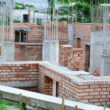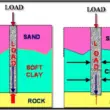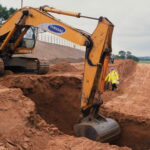Depending upon the type of highway pavement, flexible or rigid the highway material required for highway construction is decided.
This post contains general information regarding the Types of highway materials used in a construction of different types of highways and their characteristics are also discussed.
 |
| Highway Materials Types and Characteristics |
Following 7 types of highway materials are of major importance which are used in normal highway construction
are:
- Bituminous Materials
- Soil
- Aggregates
- Portland Cement Concrete
- Admixtures
- Pavement Marking Materials
- Structural Steel
Bituminous Materials
- Bituminous material, or bitumen in the form of asphalt, is one of the major highway construction materials used.
- Its use ranges from binders for the highest type pavements of complex engineering designs for the ultimate traffic, to direct spray
- applications.
- To protect an existing pavement or to provide a low-cost, all-weather road for a minimum of traffic.
- Asphalt materials, as used, range in consistency from semisolid to liquid products, which are processed and blended to conform to specification requirements for various types and grades.
- Asphalt is normally a residue product from the distillation of crude oil and, as refined, is a heavy, viscous material that is semisolid at normal atmospheric temperatures.
- By controlled processing or blending desired viscosity and hardness
- characteristics can be produced.
- This product is called asphalt cement and is also known as paving grade or penetration grade asphalt.
- Bituminous Materials, of the Highway Materials Manual contains the test procedures, sampling requirements, and test equipments.
Necessary to characterize and control, within specification requirements, asphalt cements, cutback asphalts, emulsified asphalts, and asphalt -aggregate mixtures.
Emulsified asphalt,
- Emulsion, is made from asphalt cement.
- It is tiny particles of asphalt cement mixed with water and an emulsifying agent — usually a detergent.
- Emulsions are called liquid asphalts because, unlike asphalt cements, they are liquid at normal air temperatures and therefore do not require heat to liquefy.
- To produce emulsions, hot asphalt cement and water containing the emulsifying agent are pumped at high pressure through a colloid mill.
- The emulsifying agent coats the asphalt particles and puts an electric charge on their surfaces.
- This charge causes the asphalt droplets to repel one another so they don’t combine.
- These charges are used to categorize emulsions as cationic (positive charge) or anionic (negative charge).
- Charges are important because they affect the compatibility of emulsion with mineral aggregates.
- An anionic emulsion should be used with limestone aggregate that usually bears a positive surface charge.
- A cationic emulsion should be used with sandstone because these aggregates usually bear a negative surface charge.
- After an emulsion is mixed with aggregates it sets or breaks.
- The asphalt droplets react with the aggregate and combine, squeezing out the water.
The water then evaporates, leaving the asphalt droplets to set and produce a continuous film on the aggregates.
Like Us on Facebook!
Advantages:
The following advantages have been reported for chip seals when using:
1. An asphalt binder less soft in hot weather and less brittle in cold weather.
2. Improved asphalt binder adhesion and strength for increased cover aggregate/chip retention.
3. The ability for earlier sweeping to remove excess chips.
4. The surface treatment of roads, streets and highways with higher traffic volumes and
speeds.
5. Allows for the use of larger size chips.
Subscribe Us on YouTube!
Soils
- Major works of man since the beginning of time have depended on the use of soils.
- Not only does soil form the foundation, or supporting surface for buildings, bridges, roadways and culverts, but it is the most common constituent, in the form of aggregate, in the works themselves.
- Soils are the most basic abundant material in highway engineering and as such, are well characterized by the expression \”common as dirt.\”
- The steps taken to prepare foundations manipulate and transport soils and prepare them for use as aggregates accounts for well over 70 percent of the total cost of construction for a normal highway project.
- It is easy to see then why knowledgeable consideration of every aspect of soils is very important to successful highway engineering.
Aggregates
- The surface, base, and sub base of pavements consist of aggregates or a mixture of aggregates with cement and water (Portland cement concrete) or a bituminous material (bituminous concrete).
- The strength properties of a layer are a function of both the quality and the proportions of ingredients.
- Aggregates are hard, durable, mineral materials obtained by mining or quarrying operations of deposits of sand, gravel, talus or ledges, and may be defined as \”granular material of mineral composition.
- Used either in combination with a binding medium to form bituminous concrete, Portland cement concrete, mortar, plaster, etc., or alone as in road bases, railroad ballast, filter beds, etc.\”
Portland Cement Concrete
- Portland cement concrete is a mixture of portland cement, water, air, sand and gravel or crushed stone.
- It is formed when the cement and water (paste) combine chemically and binds the entire mixture into a rock-like mass.
- It may be thought of as a two component material; paste and aggregate.
- The paste is comprised of cement, water, and entrained air.
- The aggregate portion is generally composed of sand and gravel and comprises 70 to 80 percent of the volume of the concrete.
- Aggregates both fine and course, should be selected for their quality, strength, durability and resistance to environmental affects.
- They should be smoothly graded. The quality of the concrete depends also on the quality of the paste.
- In properly made concrete each particle of aggregate is completely coated with paste and all of the space between particles is filled with paste.
Admixtures
- In recent years there have come into use a number of additives developed to improve various characteristics of concrete in both the plastic and hardened states.
- Other additives gaining in usage are known as water reducing admixtures and set retarding admixtures.
- Water reducing additive is intended to impart more workability into a plastic concrete with less water, thereby increasing its strength through a reduced water/cement ratio.
- Set retarding additive is intended to slow the setting characteristics of the mix and thereby allowing more time for placing and finishing.
- However, these additives are of diverse chemical compositions and can produce adverse reactions when used in a mix, either between the additives themselves when combined in a mix or with the cement, aggregates or water making up the mix.
- Any time an additive is proposed for use in a mix, trial mixes should be made with the additives to evaluate their effectiveness and to check for any adverse reactions.
Pavement Marking Materials
- Pavement markings have important functions in providing guidance and information to drivers.
- Pavement markings convey important information to drivers without diverting their attention from the road.
- In some cases they supplement regulations or warnings given by other devices.
- In other cases they are used alone and produce results that cannot be obtained
- by any other device.
- Many materials can be used for pavement marking.
- The choice depends on cost, durability, reflectivity, pavement surface, and drying time.
Paint
Water-based paint, applied either cold or hot, is the most commonly used pavement marking. It is low cost with a short drying time, but its visibility on wet nights is just moderate.
Thermoplastics
These pavement-marking materials are made of thermoplastic heated to about 400° F and spread onto the pavement surface. Glass beads to increase reflections can be spread on top, mixed in, or both. Thermoplastics have a long service life, good
visibility, and good reflectivity.
Epoxy
Also applied as a liquid with special equipment, epoxy has good visibility and reflectivity, and cost is moderate. Markings remains 3 to 4 years.
Tapes
Pre-formed tape can be either inlaid as part of
new construction, or overlaid. It has excellent visibility
and reflectivity and lasts 7-8 years, but is higher
cost. Wet reflective tape has excellent wet night reflectivity
with about a 4-year life. Cost is medium
and durability is poor






















